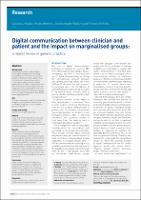| dc.contributor.author | Huxley, Caroline J | |
| dc.contributor.author | Atherton, Helen | |
| dc.contributor.author | Watkins, Jocelyn Anstey | |
| dc.contributor.author | Griffiths, Frances | |
| dc.date.accessioned | 2022-08-31T04:14:31Z | |
| dc.date.available | 2022-08-31T04:14:31Z | |
| dc.date.issued | 2015-12 | |
| dc.identifier.issn | 0960-1643, 1478-5242 | |
| dc.identifier.uri | https://resources.equityinitiative.org/handle/ei/476 | |
| dc.description.abstract | Background Increasingly, the NHS is embracing the use of digital communication technology for communication between clinicians and patients. Policymakers deem digital clinical communication as presenting a solution to the capacity issues currently faced by general practice. There is some concern that these technologies may exacerbate existing inequalities in accessing health care. It is not known what impact they may have on groups who are already marginalised in their ability to access general practice. Aim To assess the potential impact of the availability of digital clinician–patient communication on marginalised groups’ access to general practice in the UK. Design and setting Realist review in general practice. Method A four-step realist review process was used: to define the scope of the review; to search for and scrutinise evidence; to extract and synthesise evidence; and to develop a narrative, including hypotheses. Results Digital communication has the potential to overcome the following barriers for marginalised groups: practical access issues, previous negative experiences with healthcare service/staff, and stigmatising reactions from staff and other patients. It may reduce patientrelated barriers by offering anonymity and offers advantages to patients who require an interpreter. It does not impact on inability to communicate with healthcare professionals or on a lack of candidacy. It is likely to work best in the context of a pre-existing clinician–patient relationship. Conclusion Digital communication technology offers increased opportunities for marginalised groups to access health care. However, it cannot remove all barriers to care for these groups. It is likely that they will remain disadvantaged relative to other population groups after their introduction. | |
| dc.format.extent | e813-e821 p. | |
| dc.format.mimetype | application/pdf | |
| dc.language.iso | en | |
| dc.publisher | British Journal of General Practice | |
| dc.rights | ©British Journal of General Practice | |
| dc.subject | Access to health care | |
| dc.subject | communication | |
| dc.subject | doctor-patient relations | |
| dc.subject | general practice | |
| dc.title | Digital communication between clinician and patient and the impact on marginalised groups: a realist review in general practice | |
| dc.title.alternative | Digital communication between clinician and patient and the impact on marginalised groups | |
| dc.type | journalArticle | |
| dc.identifier.doi | 10.3399/bjgp15X687853 | |

